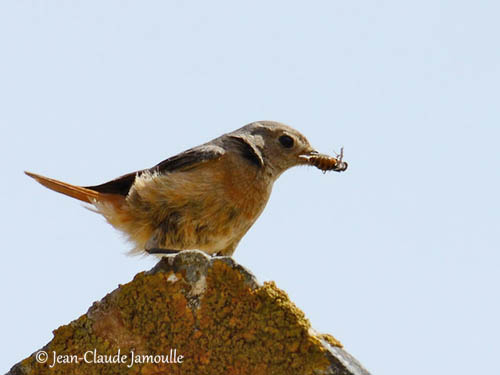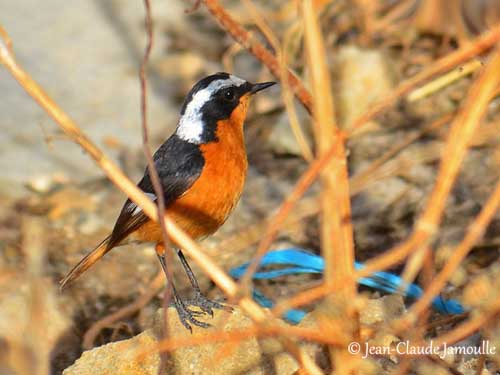
Fr: Rougequeue de Moussier
All : Diademrotschwanz
Esp : Colirrojo Diademado
Ital : Codirosso algerino
Nd: Diadeemroodstaart
Sd: Diademrödstjärt
Photographers:
Didier Buysse
Vision d’Oiseaux
Jean Michel Fenerole
Photos d’Oiseaux du monde
Jean-Claude Jamoulle
A la rencontre des Oiseaux
Text by Nicole Bouglouan
Sources:
HANDBOOK OF THE BIRDS OF THE WORLD Vol 10 by Josep del Hoyo-Andrew Elliott-David Christie - Lynx Edicions - ISBN: 8487334725
GUIDE HEINZEL des Oiseaux d’Europe de Hermann Heinzel, Richard Fitter et John Parslow – Delachaux et Niestlé – ISBN : 2603014862
BirdLife International (BirdLife International)
Ornithomedia - Le Web de l’Ornithologie
Wikipedia, the free encyclopaedia
Moussier’s Redstart
Phoenicurus moussieri
Passeriforme Order – Muscicapidae Family
BIOMETRICS:
Length: 12 cm
Wingspan: 18-20 cm
Weight: 14-15 gr
DESCRIPTION:
Moussier’s Redstart is classified as an Old World Flycatcher in the Muscicapidae family. This species is endemic to Atlas Mountains of NW Africa. A bright-coloured birds of dry rocky areas!
The adult male has black head, contrasting strongly with long, white band from forehead, along supercilium and around rear ear-coverts, ending on the nape. Chin and throat are rusty-orange, like all underparts.
On the upperparts, back and wings are black. We can see a white wing patch on flight feathers. The tail is rusty-orange with blackish central rectrices. The rump is rusty-orange too.
In fresh plumage, feathers are scaled buff overall.
Bill, legs and feet are black. Eyes are dark brown.

The female is much duller with brown upperparts and orange-buff underparts.
The juvenile resembles female but it has mottled or scaled dark markings on buff underparts, and especially on throat and breast. Belly is more uniform. The young male has black wings with white patch.
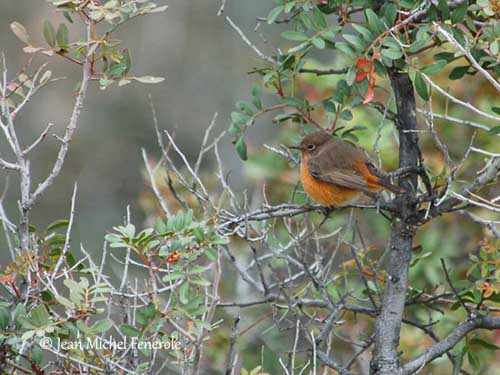
VOICE: SOUNDS BY XENO-CANTO
Moussier’s Redstart gives frequent high-pitched “iiip iiip” usually followed by rasping “tr-rr-rr”, used as contact and first alarm call. Both calls can be combined in stronger alarm near the nest “pi-chirrr” or “psew” too.
Male’s song is a series of phrases, a mixture of rasping sounds and “svee-svee” notes “zirezrize zerizerizer zerezerizera”. We can also hear soft, rapid series of low whistles, chirrups and chuckles.
HABITAT:
Moussier’s Redstart frequents open rugged hills and stony plateaux with scrub, dry areas with bushes and scattered trees, higher rocky meadows, open woodlands, cedar forest’s clearings and edges, between 500 and 3200 metres of elevation.
But it may occur in coastal areas, orchards or cultivated valleys in SW Morocco, whereas in the eastern part of the range, it is found in dry, grassy, rocky or stony slopes with low bushes and scrub, and areas with scattered large trees, between 1500 and 2300 metres of elevation.
During winter, it occurs at lower elevation in flat, more desert areas with scrub and bushes near water and on plains.
RANGE:
Moussier’s Redstart is found in Morocco, E to Tunisia.
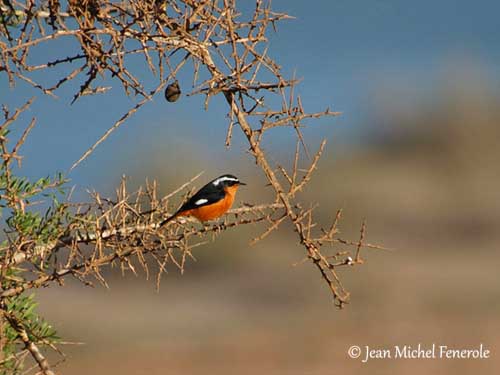
BEHAVIOUR:
Moussier’s Redstart feeds primarily on various insects. Its feeding behaviour is that of a flycatcher, making aerial sallies for catching passing insects. It perches on bushes or tree branches from which it flies and catches the prey on the ground. It may sometimes dig into the soil with the bill to find invertebrates. On the ground, it hops around and usually returns to the perch. Small berries can be taken occasionally.
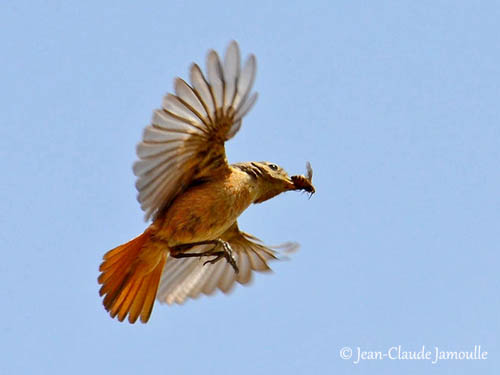
Like other Phoenicurus species, Moussier’s Redstart performs distinctive body movements such as shivering or flicking the tail or flicking the wings too, and exposing the bright-coloured rump.
These movements are prominent visual signals used between mates or towards other birds. They usually indicate the bird’s presence and its intentions.
This species is territorial and socially monogamous. The male utters advertising songs in order to proclaim and maintain its breeding site. Some displays, both aerial and terrestrial, may occur, during which the rich, bright-coloured plumage pattern is conspicuously exposed, as well in courtship displays as in threat and defence behaviour.
Raising and quivering wings expose the bright rusty-orange underparts. The tail fanned and lowered shows off rump and rectrices. The head pattern is enhanced by several postures with head lowered and stretched forwards.
These displays are usually accompanied with soft sounds.
Moussier’s Redstart is sedentary, but it performs altitudinal movements and post-breeding dispersals. Some of them can be partially migratory too.
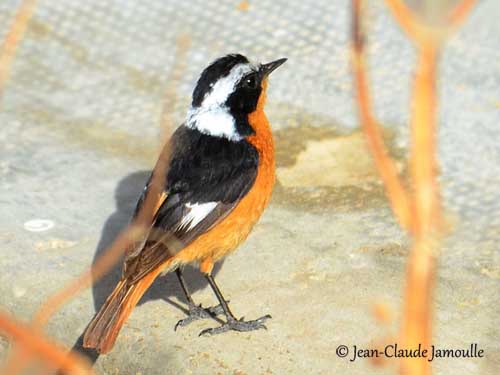
FLIGHT:
Moussier’s Redstart has an agile flight like all flycatchers.
REPRODUCTION:
The breeding season may vary according to the range and the elevation, but usually occurs between mid-March and August.
Moussier’s Redstart nests on the ground in the shelter of the vegetation such as bush, thorny scrub, grass tussock, but also in tree fork or bush, at about two metres above the ground. The nest may occur among boulders or in various cavities such as hole in wall, bank, tree trunk or roof.
The nest is a cup made with coarse grass and lined with hair and feathers.
The female lays 4-5 pale blue or white eggs. The nest is sometimes parasitized by the Common Cuckoo.
There is no more available information.
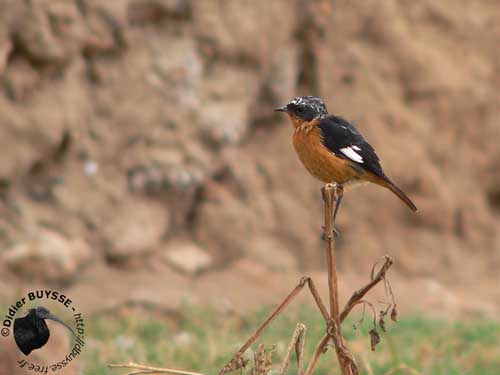
DIET:
Moussier’s Redstart feeds mainly on insects, primarily ants, but also beetles, grasshoppers and larvae. It may take sometimes small berries and olive flesh.
It performs aerial sallies, hunts from perches and hops on the ground.
PROTECTION / THREATS / STATUS:
Moussier’s Redstart is fairly common in its range, and its populations are not currently threatened.
